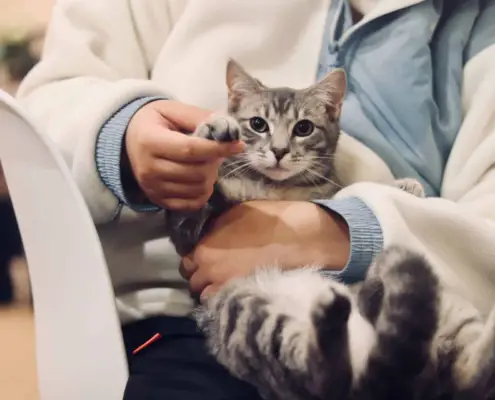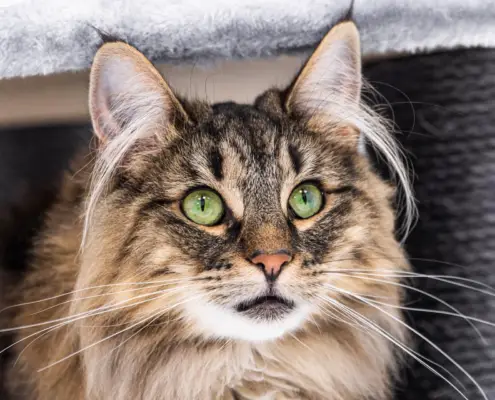
Cats have long been admired for their grace and elegance when they move. Whether it’s a leisurely stroll or a lightning-fast sprint, their movements are nothing short of mesmerizing. But have you ever wondered why cats ambulate the way they do? In this article, we will delve into the science behind feline elegance and explore the reasons why cats ambulate.
The Anatomy of a Cat’s Legs and Feet
To understand why cats ambulate so gracefully, it is important to examine the anatomy of their legs and feet. Cats have a unique skeletal structure that allows for maximum flexibility and agility. Their legs are slender and muscular, providing them with the power and speed needed for hunting and climbing.
The feet of a cat are also specialized for ambulation. Cats are digitigrade walkers, meaning they walk on their toes. This design allows for a more efficient and silent movement. The pads on their paws provide cushioning and help with shock absorption, enabling them to move swiftly and silently.
The Evolutionary Reasons Behind Cat Ambulation
The elegant ambulation of cats can be traced back to their evolutionary history. Cats are descended from a long line of hunters, and their ambulation style has developed over millions of years to optimize their hunting abilities.
In the wild, cats need to be stealthy and agile to catch their prey. Their ability to move silently and quickly is crucial for survival. Through natural selection, cats with the most efficient ambulation style were more successful at hunting and passing on their genes. Over time, this led to the development of the graceful ambulation we see in cats today.
How Cats Use Their Tail for Balance While Ambulating
One key aspect of cat ambulation is the use of their tail for balance. The tail acts as a counterbalance, helping cats maintain stability and adjust their body position while moving. It serves as a rudder, allowing them to make quick turns and changes in direction.
Cats have an incredible sense of balance, and their tail plays a crucial role in this. When cats are walking on narrow surfaces or leaping from heights, they use their tail to maintain equilibrium. It acts as a natural stabilizer, ensuring that they land safely and maintain their elegant movements.
The Different Types of Cat Gaits and Their Purposes
Cats have several different gaits, each serving a specific purpose. The most common gait is the walk, where the cat moves both legs on one side of the body followed by the legs on the other side. This gait is used for slower movements and when the cat wants to conserve energy.
Another gait commonly seen in cats is the trot. In this gait, the cat moves its diagonal legs together, creating a smooth and efficient movement. The trot is often used when cats want to move quickly but not at their maximum speed.
When cats need to sprint or chase prey, they use the gallop gait. In this gait, the cat extends its body fully, with all four legs leaving the ground simultaneously. This allows for maximum speed and is often seen during intense play sessions or hunting.
Factors That Influence a Cat’s Ambulation Style
Several factors can influence a cat’s ambulation style. One of the most significant factors is the cat’s size and breed. Smaller cats tend to be more agile and have a lighter gait, while larger cats may have a more powerful and deliberate ambulation style.
The cat’s environment also plays a role in their ambulation. Indoor cats may have a more relaxed and leisurely gait, as they have less need for hunting and navigating challenging terrains. Outdoor cats, on the other hand, may display more intense and purposeful movements as they encounter various obstacles and prey.
Additionally, a cat’s physical condition and age can impact their ambulation style. Older cats may develop a more cautious and measured gait, while kittens may have a playful and erratic ambulation style as they are still developing their coordination and balance.
Common Misconceptions About Cat Ambulation
There are several misconceptions about cat ambulation that are worth addressing. One common misconception is that cats always land on their feet. While cats have a remarkable ability to twist their bodies midair and land on their feet, they are not invincible. They can still suffer injuries from falls, especially from great heights.
Another misconception is that cats’ ambulation is completely silent. While cats are indeed silent walkers, they do make some noise when they walk. The sound is just significantly muffled compared to other animals.
Fascinating Facts About Cat Ambulation
Here are some fascinating facts about cat ambulation:
- Cats have a specialized walk called the “stalking walk,” where they walk on their tiptoes, creating a slow and deliberate movement.
- Cats have a unique gait called the “amble,” where they move their front and back legs on the same side of the body at the same time, creating a lateral movement.
- Cats have retractable claws, which allow them to walk silently and maintain the sharpness of their claws.
Observing and Understanding Your Cat’s Ambulation Behavior
By observing your cat’s ambulation behavior, you can gain insights into their mood, health, and overall well-being. A cat that moves with ease and grace is likely in good physical condition. However, if you notice any changes in their gait, such as limping or favoring one leg, it may indicate an underlying health issue that requires veterinary attention.
You can also observe your cat’s ambulation during playtime. Cats often exhibit their full range of movements during play, which can give you a better understanding of their physical abilities and preferences. Additionally, engaging in interactive play sessions with your cat can help keep them physically active and mentally stimulated.
The Beauty and Grace of Cat Ambulation
In conclusion, the science behind feline elegance is a fascinating topic to explore. Cats’ ambulation is a result of their unique anatomy, evolutionary history, and need for efficient hunting and survival. Their graceful movements, aided by their tail for balance, are a true marvel to behold.
By understanding the factors that influence a cat’s ambulation style and observing their behavior, we can deepen our bond with these incredible creatures. So the next time you see a cat gracefully moving through the world, take a moment to appreciate the beauty and grace of their ambulation.
If you enjoyed my article, I would appreciate you sharing it with your network.

Sima Ndlebe
Sima writes for CatBuzz. He is interested in Cats, Health and Fitness, and Entrepreneurship.
Published: 14 November 2023



